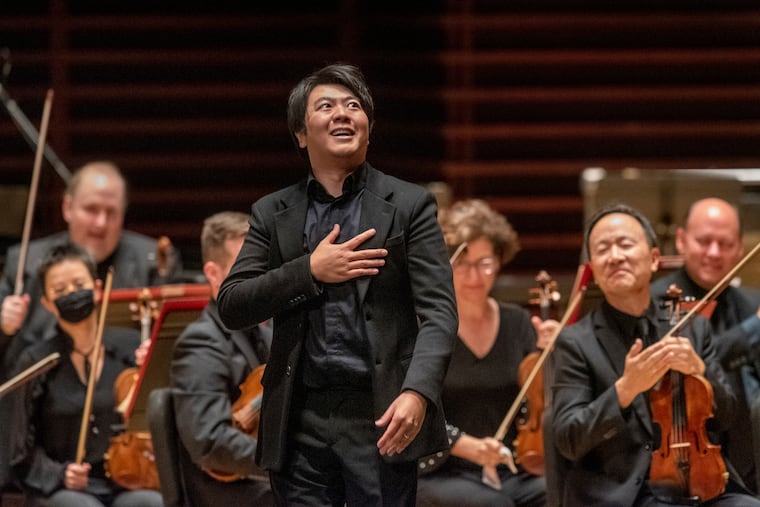Pianist Lang Lang opens Philadelphia Orchestra season with a $900K gala and a Disney twist
The star pianist was back in town with an odd programming twist — but one that worked.

The hall was full, the talk of rebirth. No one can really say for sure whether audiences will repopulate the city’s theaters and revivify an arts and culture scene battered by the pandemic.
But as a symbol of Philadelphia’s resiliency, the Philadelphia Orchestra put out a bullish message on Wednesday night for its season opener. Many at the reception before and dinner afterward said it was their first non-masked outing since the start of the pandemic, and if Verizon Hall was at capacity it might be seen less as an all-clear signal than a widely adopted risk-reward calculation.
Let’s face it: A routine overture, concerto, or symphony might not be worth contracting COVID-19. But the return of Lang Lang — whom Philadelphians have known from his Curtis days — is a risk worth taking.
Lang Lang, now 40, is a classical music celebrity, but he is essentially the same pianist he was when he arrived at the Curtis Institute of Music from China as a teenager.
But the lure of a big name works magic. In a tough year, the keyboard star helped to bring 2,300 listeners to opening night. The gala grossed $923,000 and will benefit the orchestra and Kimmel Center.
Despite astonishing technique, Lang Lang’s free-wheeling interpretive ideas seem random.
Rhyme and reason in Saint-Saëns’ Piano Concerto No. 2 in G Minor was hard to discern, though he was clearly intent on prodding the first movement from its Bach-inspired moorings to something more of the Romantic era. It wasn’t merely flexible in tempo, but extravagantly free. Music director Yannick Nézet-Séguin and the orchestra followed with total buy-in.
Lang Lang was appropriately ebullient in the second movement and dangerously fun in the daring third. But if he had made the first movement any more grandly tragic, a candelabra might have materialized upon the piano.
His Mary Poppins encore? Well, yes, the pianist has been signed by Disney. So is anyone surprised?
Oddly, it was the encore that was Lang Lang’s more convincing artistic statement: “Feed the Birds” from his new album of Disney tunes. This arrangement by pianist Stephen Hough starts out simply but veers far from its source in harmonically imaginative ways. It’s easy to be cynical about what seems like just another Disney product. This arrangement, however, provides a good entry point and then becomes something more challenging to the ear.
In a bit of image shaping, the orchestra presented a video during the concert in which Nézet-Séguin spoke about the ensemble’s place in a world struggling for social justice and referred to the orchestra as a “transformed institution.” While other orchestras (Cleveland, Pittsburgh) were touring Europe this summer with traditional repertoires like Bruckner, Strauss, Beethoven, and Tchaikovsky, the Philadelphia Orchestra was introducing Europeans to Florence Price, the Black female composer whose works are prominent throughout the coming season.
The performance of Dvorak’s Symphony No. 8 seemed like an interpretation still searching for a stronger point of view.
Valerie Coleman, another composer being championed by the orchestra these days, came away from reviews on the orchestra’s European tour bristling at how some critics heard Aaron Copland’s hand in her music.
“I gotta say it: It’s an easy way out for critics to compare new works to what they know in Western Classical, especially when it comes to critiquing the works of Black composers,” she wrote in a Facebook post.
“Perhaps consider instead of saying that a Black composer’s work sounds like Copland, try to see the presence of the Black church, gospel music and spirituals where major triads and minor thirds flow from both faith and trial.”
It was Coleman’s Umoja: Anthem for Unity, which the orchestra performed Wednesday night, and whatever your cultural touchstones may be, it was impossible to hear the composer’s score as anything but a bubbling spring of hope.
The music would have made a strong enough statement on its own, but on this night the orchestra transformed it into a ballet score. American dancer Tiler Peck set Coleman’s work on 10 dancers from BalletX, who, in pairs, solos, and small groups, met Coleman’s jazz-tinted score with an essentially classical visual vocabulary, but often in quite emotional terms. Freedom emerged from tension. And here, in both the music and choreography, individualism and unity not only coexisted but soared.